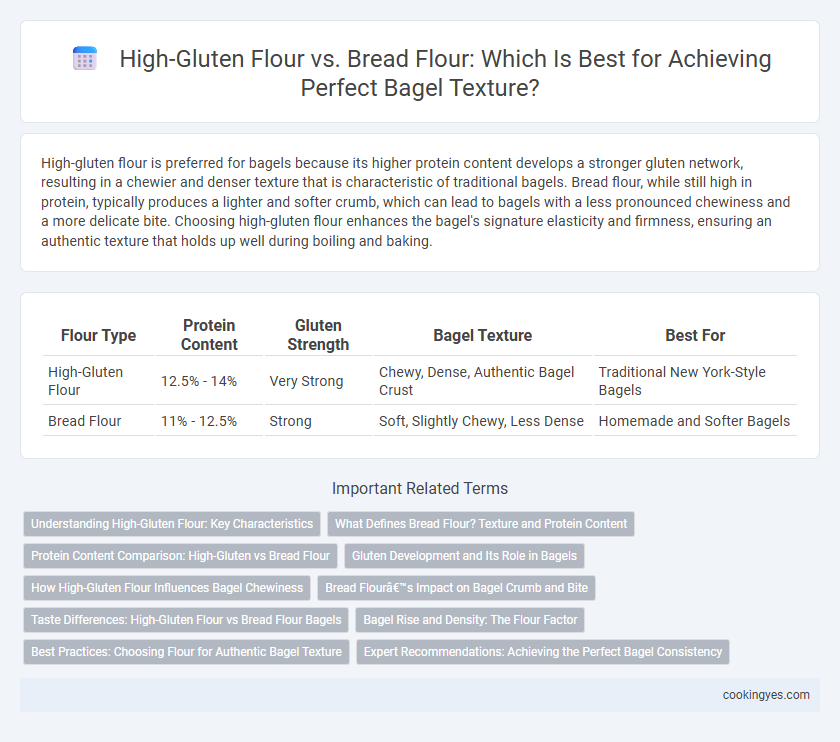High-gluten flour is preferred for bagels because its higher protein content develops a stronger gluten network, resulting in a chewier and denser texture that is characteristic of traditional bagels. Bread flour, while still high in protein, typically produces a lighter and softer crumb, which can lead to bagels with a less pronounced chewiness and a more delicate bite. Choosing high-gluten flour enhances the bagel's signature elasticity and firmness, ensuring an authentic texture that holds up well during boiling and baking.
Table of Comparison
| Flour Type | Protein Content | Gluten Strength | Bagel Texture | Best For |
|---|---|---|---|---|
| High-Gluten Flour | 12.5% - 14% | Very Strong | Chewy, Dense, Authentic Bagel Crust | Traditional New York-Style Bagels |
| Bread Flour | 11% - 12.5% | Strong | Soft, Slightly Chewy, Less Dense | Homemade and Softer Bagels |
Understanding High-Gluten Flour: Key Characteristics
High-gluten flour contains 12-14% protein, providing superior strength and elasticity essential for the dense, chewy texture of traditional bagels. Its higher gluten content compared to bread flour, which typically has 11-13% protein, ensures better dough structure and a chewier crumb. Using high-gluten flour enhances water absorption and dough resilience, resulting in a classic bagel bite with optimal chewiness and crust.
What Defines Bread Flour? Texture and Protein Content
Bread flour is defined by its higher protein content, typically ranging from 11% to 13%, which enhances gluten development crucial for bagel texture. This increased gluten forms a strong, elastic dough that yields the chewy, dense interior characteristic of classic bagels. High-gluten flour surpasses bread flour in protein content, often reaching 14% or higher, producing an even firmer structure ideal for achieving the signature bite and crust of traditional bagels.
Protein Content Comparison: High-Gluten vs Bread Flour
High-gluten flour contains 14-15% protein, providing the strong gluten network essential for the dense, chewy texture of traditional bagels. Bread flour typically has 11-13% protein, resulting in a lighter crumb that lacks the characteristic bagel chew. The elevated protein content in high-gluten flour enhances elasticity and structure, directly influencing the bagel's signature bite and crust.
Gluten Development and Its Role in Bagels
High-gluten flour, containing 12-14% protein, promotes stronger gluten development essential for bagels' chewy texture and distinctive dense crumb. Bread flour, with slightly lower protein content around 11-13%, provides moderate gluten strength, resulting in a softer but less authentic bagel bite. The enhanced gluten network in high-gluten flour traps gas bubbles effectively during fermentation, creating the traditional bagel's characteristic chewiness and glossy crust.
How High-Gluten Flour Influences Bagel Chewiness
High-gluten flour, containing 14-15% protein, creates a stronger dough structure that enhances bagel chewiness by developing more gluten networks. This higher protein content traps carbon dioxide bubbles during fermentation, resulting in a dense, elastic crumb characteristic of traditional New York-style bagels. Bread flour, with lower protein content around 11-13%, produces a softer texture but lacks the signature chewiness essential to authentic bagel quality.
Bread Flour’s Impact on Bagel Crumb and Bite
Bread flour, with its moderate protein content of around 11.5-13%, contributes to a bagel crumb that is tender yet resilient, striking a balance between chewiness and softness. The gluten development in bread flour creates a slightly less dense bite compared to high-gluten flour, resulting in a texture that is pleasantly springy but not overly tough. This makes bread flour ideal for those seeking a classic bagel crumb that holds shape well while maintaining an inviting, easy-to-bite feel.
Taste Differences: High-Gluten Flour vs Bread Flour Bagels
High-gluten flour produces bagels with a chewier, denser texture and a slightly sweeter taste due to its higher protein content, which enhances gluten development and caramelization during baking. Bread flour bagels tend to have a lighter, less dense crumb and a milder flavor, resulting in a softer chew and less pronounced crust. The choice between high-gluten and bread flour significantly influences the bagel's overall eating experience, with high-gluten flour preferred for traditional, authentic bagels.
Bagel Rise and Density: The Flour Factor
High-gluten flour significantly enhances bagel rise and chewiness due to its superior protein content, which forms a strong gluten network essential for trapping gas during fermentation. Bread flour, while suitable, produces a slightly less dense and chewy texture because its lower gluten level results in a weaker gluten matrix. Choosing high-gluten flour optimizes the bagel's characteristic dense interior and robust crust, directly influencing its traditional texture and rise.
Best Practices: Choosing Flour for Authentic Bagel Texture
High-gluten flour, with a protein content of 13-14%, is ideal for authentic bagel texture, providing the necessary chewiness and dense crumb by developing strong gluten networks. Bread flour, containing slightly less protein (around 11-13%), can be used but may result in a softer, less resilient bagel texture. For best results, bakers often prefer high-gluten flour to achieve the traditional chewy exterior and dense interior characteristic of classic New York-style bagels.
Expert Recommendations: Achieving the Perfect Bagel Consistency
High-gluten flour is preferred by experts for bagels due to its higher protein content, typically 13-14%, which develops a stronger gluten network and yields the chewy, dense texture characteristic of traditional bagels. Bread flour, with slightly lower protein content around 11-12%, produces a softer crumb and less elasticity, making it less ideal for achieving the classic bagel bite. Professional bakers recommend using high-gluten flour combined with proper kneading techniques to optimize the bagel's firmness and characteristic chewiness.
High-gluten flour vs bread flour for bagel texture Infographic

 cookingyes.com
cookingyes.com